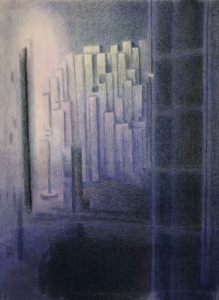John McDevitt King, By Barcelona, 2021, Colored pencil on paper, 15″ x 11″
Intersections I, a three-person show, is on view at Anita Rogers Gallery in Soho through January 7, featuring Gary Gissler, Barbara Knight, and John McDevitt King. I’m sharing excerpts from a catalogue essay on John’s work, published on the occasion of his solo show at MERGE Stone Ridge in 2022.
Excerpts from Stealing Light
In the field of gemology, John McDevitt King has evaluated some of the world’s legendary gemstones, including the Hope Diamond. A specialty of his involves noting subtle variations in color, undetectable to most of us, as well as degrees of clarity and other qualities that factor into each stone’s evaluation. But before working with gems, John was a practicing artist. Over decades, as his professional expertise has been honed, his artmaking has evolved in tandem. The two are intertwined, creating an essential, sui generis dialogue that emerges in his artwork.
John perceives the way light is projected, filtered, or reflected, and how it clarifies or obstructs vision; gauges its ephemerality and opacity; and harnesses those perceptions for inspiration. How does he continue to find source material for subject matter? “More often, I start from something observed. That could be a fragment of a photo, something I see around me, direct observation… that goes through transitions as I being to work on it.” He often returns to objects of earlier inspiration, such as a series based on broken plates of glass and the chance patterns therein. At other times, he looks—and then sees. “Some works are reflective of being in my studio and looking at the windows… what I’m seeing on the surface, past the surface, and behind,” similar to the process of looking at a diamond. He nods at Jasper Johns: “You take an object and turn it a different way, or block something out, or twist this, or change the focus of the form—and you see it anew.”
It’s one thing to create subject matter. It’s quite another to render that in a typically two-dimensional work using traditional media. John has been experimenting in recent years with such divergent materials as 3-D printing, video, printmaking, and paper fabrication, but he continually returns to drawing and encaustic painting as the most pure means of expression. “Drawing and encaustic painting somehow embody my personality and the way I put myself in a position to make art.”
Encaustic involves combining melted beeswax with pigment, which can be layered and textured to create dimension. John notes: “I continually explore ways to handle the paint, move it around, pouring, layering, different strokes.” He most often draws with graphite on white or light paper, but he has also used white pigment on black paper. In any case, he says,”Drawing goes back to childhood. I continue to find that one of the most pleasing forms of interaction that I have in my work.” And his technical methods in grading diamonds have been put to use in painting. In a recent conversation, he noted: “There’s a certain touch that I use in diamond grading that I tend to use also in painting—a movement of the hand focused on attention to detail.”
John finds general inspiration in New York City, whether from cityscapes or simply within his studio at the Brooklyn Navy Yard; his work expresses “a specific kind of feel, but not a specific place.” One look at his Instagram feed is a glimpse of how a given visual cue can be the impetus for a new composition. Identifiable objects might become the framework for an abstraction; a lightbulb, the pinpoint focus in a drawing; a window, a mysterious portal. For a non-artist, it can help to understand how a simple walk can produce an endless array of inspiration.
—Susan Yung, 2022
